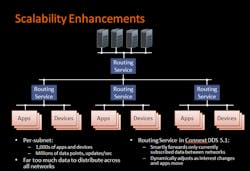The Object Management Group’s (OMG) Data Distribution Service (DDS) defines a distributed publish/subscribe application environment (see What’s The Difference Between DDS And AMQP?). DDS can simplify application design and configuration allowing a system to grow without major modifications to the underlying system. One challenge occurs when these systems become very large. Another challenge is how these systems grow. Often clients will need to have different versions of the DDS client and there is always the issue of changing data definitions.
This file type includes high resolution graphics and schematics when applicapable.
Real Time Innovation’s Connext DDS 5.1 is designed for very large, distributed application environments. Developers can incorporate transparent routers into a large network to provide more efficient data distribution (see the figure).
Related Articles
- What’s The Difference Between DDS And AMQP?
- Data Distribution Service Scales From Embedded To The Enterprise
- DDS V1.0 Standardizes Publish/Subscribe
- The DDS Standard
The routers improve system scalability. Typically multicast is used if there are more than four subscribers on a subnet. A router will only capture and forward a single instance of published data even if it needs to be redistributed to multiple clients. The router monitors subscriptions to help it manage distribution of data.
RTI’s DDS employs UDP instead of TCP but this version adds TCP like capabilities. For example, the auto throttle support acts like TCP’s windowing support. Turbo mode optimizes for throughput.
Another new feature is built-in Quality of Service (QoS) profiles. The 20 QoS profiles include presets for the DDS system For example, one present is designed for large data packets that are exchanged frequently where high reliability is important but the data rate will be low. Developers only need to choose one of the profiles that best fit their needs. Of course, developers can always tweak the system as needed.
Connext DDS 5.1 now support OMG’s DDS-XTypes (extensible types). DDS-XTypes define how to remap data. For example, version 1 some published data might use single precision floating point. Version 2 might use double precision data instead. A client would have to change without DDS-XType support if the client utilized version 1 and the publisher is now generating version 2 data. The mapping of data can be more sophisticated than just changing variable data types.
DDS-XTypes provides a way to define the translation of data from one format to another. The support is at the client side allowing newer version clients to utilize older format published data.
Connext DDS is used in a wide range of applications from military to medical networks. It can handle millions of data points and it can easily handle dynamic reconfiguration.
About the Author
William G. Wong
Senior Content Director - Electronic Design and Microwaves & RF
I am Editor of Electronic Design focusing on embedded, software, and systems. As Senior Content Director, I also manage Microwaves & RF and I work with a great team of editors to provide engineers, programmers, developers and technical managers with interesting and useful articles and videos on a regular basis. Check out our free newsletters to see the latest content.
You can send press releases for new products for possible coverage on the website. I am also interested in receiving contributed articles for publishing on our website. Use our template and send to me along with a signed release form.
Check out my blog, AltEmbedded on Electronic Design, as well as his latest articles on this site that are listed below.
You can visit my social media via these links:
- AltEmbedded on Electronic Design
- Bill Wong on Facebook
- @AltEmbedded on Twitter
- Bill Wong on LinkedIn
I earned a Bachelor of Electrical Engineering at the Georgia Institute of Technology and a Masters in Computer Science from Rutgers University. I still do a bit of programming using everything from C and C++ to Rust and Ada/SPARK. I do a bit of PHP programming for Drupal websites. I have posted a few Drupal modules.
I still get a hand on software and electronic hardware. Some of this can be found on our Kit Close-Up video series. You can also see me on many of our TechXchange Talk videos. I am interested in a range of projects from robotics to artificial intelligence.



